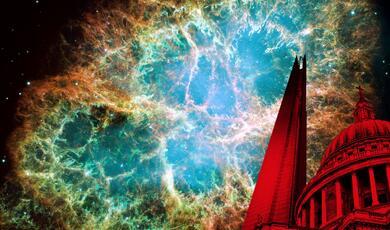What’s the Matter with Antimatter?
Share
- Details
- Text
- Audio
- Downloads
- Extra Reading
Antimatter sounds like the stuff of science fiction, but in fact it is real and a major tool in medicine, technology and science. This talk introduces antimatter and one of the biggest mysteries in cosmology: why is there no antimatter in the universe at large? Experiments about to begin in California hope to find clues to the answer.
Download Text
Professor Frank Close OBE
I spent the last two weeks in the USA and am exhausted from having spent all night watching their presidential election results, let alone the nervous exhaustion of what has happened since. Their presidential race is perfectly balanced, as is the split in their Senate and (almost) their congress. Such perfect symmetry could well cause major problems: to operate the USA will have somehow to break this symmetry. Perfect symmetry, while appealing to mathematicians, has to be broken for things to happen. As in the USA today, so it was 15 billion years ago immediately after the Big Bang. Matter and antimatter had been created in the Big Bang in equal amounts, according to today's best theory. However, when matter and antimatter touch, they annihilate. Had that symmetry not been broken, there would have been no universe today. Today the universe appears very different to this: we, the planets, the Sun and, as far as we can tell, whole galaxies of stars are made entirely of matter. Antimatter in bulk appears to be absent from our universe. We should be thankful that this is so. The big question is how did this happen? That is what experiments are currently trying to answer and in this and the next talk I shall be telling you about the current state of the art.
MATTER
But first, let me introduce you to antimatter; and indeed to the nature of matter. The basic elements are made of tiny atoms. Each breath contains a million million million million atoms of oxygen. This vast number helps give an idea of how small atoms are: a hair is about a million atoms wide. So atoms are very small, but not unimaginably so. Atoms are not the smallest things: they are made of electrically charged particles: negatively charged electrons whirl at the edge and a compact positively charged nucleus is at the centre. The atoms of all elements are like this; they differ in the main by the different numbers of these electrical components. The simplest of all, hydrogen, contains a single electron encircling a single positive "proton".
The electron, to the best experimental measurements that we can yet make, appears to be a truly basic piece of matter - an "elementary" particle. The proton however, is not: it is made of smaller pieces called "quarks". Three quarks make up a proton and they are also, so far as we can tell, elementary particles. So, in a nutshell, matter is built from electrons and quarks. We have only known of the quarks since the 1960s; the electron, by contrast, was discovered in 1897 by J J Thomson in Cambridge. And it was also in Cambridge that the mathematical physicist, Paul Dirac, in 1928 came up with the idea of an "anti" version of the electron, known today as the "positron". This is where antimatter first entered the vocabulary, so to begin, let me tell you about the positron.
POSITRON
Dirac had been thinking about the two great foundations of 20th century science: Quantum Theory and Einstein's Theory of Relativity. Quantum theory deals with small scale things such as the particles that make atoms. The electron is one such. Quantum theory had explained how atoms are built - it is the electrical attraction of opposite charges (negative electron and positive proton) that is the basic glue. It also explained how their basic electrons generated the spectra of light that the atoms emit. And alt was well until careful measurements showed that these spectral lines were split in pairs when magnetic fields were around - which in turn suggested that the electron was not simply a piece of electric charge but also acts like a little magnet.
The pictorial image that we use is that the electron somehow "spins" like a top; spinning around some axis either clockwise or anticlockwise leads to the twofold split in the atomic spectra. But how can a vanishingly small piece of charge, like the electron, "spin"? An answer is that mental images that make sense in our macroscopic world are inadequate in the weird world of the quantum. "Spin" is how the electron acts, but what exactly is happening that gives it a Janus face is more profound than simple pictures. This was a question that worried the theorists, Dirac among them.
He also realised that electrons move fast, and as such are subject to the rules of relativity. It was when he combined Relativity and Quantum Theory that the miracles happened. First, the resulting equation implied that the negatively charged electron would indeed have a Janus face which acted AS IF it was spinning (we use this word always and I shall too, but always remember it is only a convenient piece of imagery and not literal truth). But Dirac's theory implied something else: it showed that the negatively charged electron also had another Janus aspect - it also must have a positively charged counterpart (which became known as the positron - the positively charged electron). This is NOT the proton. Let me introduce the positron.
An electron has a mass of 10^{-27} gms (this is 1 divide by 1 followed by 27 zeroes); in size its radius is less than 10^{-18} metres; it "spins" at a rate of "one-half' (in units of the Planck angular momentum) and carries about 10^-19} coulombs of negative electrical charge (when dealing with basic particles and ions we measure amounts of charge in terms of this and refer to it as "charge of -1").
Now lets compare the symmetry and see if you can spot the difference. An positron has a mass of 10^{-27} gms (this is 1 divide by 1 followed by 27 zeroes); in size its radius is less than 10^-18} metres; it "spins" at a rate of "one-half" (in units of the Planck angular momentum) and carries about 10^-19} coulombs of positive electrical charge ("charge of +1"). (A proton has a mass that is nearly 2000 larger than the positron or electron, and its radius is about a thousand times larger than an electron's).
FEYNMAN's PICTURES
In the 1940s the great American physicists Richard Feynman produced his beautiful mathematical description of the way that electrons and positrons act as siblings when they interact with light. His powerful maths is tantalisingly encoded in little pictures, known as Feynman diagrams, that give elegant pictorial feeling for how the particles are moving around. The theory, today known as "Quantum Electrodynamics" (QED for short) shows how electrons and positrons annihilate into gamma rays (high energy particles of light) when they meet and, conversely, how under suitable circumstances the energy in gamma rays can
"coagulate" into an electron and a positron. His work also hinted that positrons act like electrons that are travelling backwards in time, which is too much magic for today, but enables me to mention Feynman in the same breath as Dirac. Feynman was also an artist and as an example I can show a drawing that Feynman made of Dirac. I will show a diagram to help give you a feeling for how electrons and positrons can emerge. Einstein's E=mc^2 tells us that energy and mass can change back and forth. The energy carried by a photon can end up carried by an electron and positron: the total electrical charge is conserved - the photon has none and the -1 of the electron is balanced by the +1 of the positron.
POSITRON DISCOVERY AND IMAGES
So'where are these positrons? Almost as soon as Dirac had predicted them they were found in cosmic rays. Far above our heads pieces of atoms, produced by violent events in remote stars and whirled through space by the magnetic fields out there, smash into the upper atmosphere. The energy in these cosmic rays can produce electrons and positrons similar to the process in the Feynman diagram above. (They can also produce other particles and antiparticles - later). It was in observing cosmic rays that Anderson discovered the positron in 1932. He used a cloud chamber (which contains supersaturated liquid, and when an electrically charged particle passes through, it leaves a trail like the cloud trail from high flying aircraft). Put your chamber in a magnetic field and from the way that the particle is deflected you can tell if it is positively or negatively charged. Anderson found a trail that looked like that of an electron but curved the wrong way - a "positively charged electron". Once found, positrons turned up all over the place in high energy collisions. They are visible in bubble chambers (In the bubble chamber a liquid is critically about to boil - and when an electrically charged particle passes through it forms a trait of bubbles, which can be photographed). Here too magnetic fields make the particles curve and leave beautiful images. In the 1960s this was a way of "seeing" particles and an image from the Berkeley laboratory in California shows a positron and electron curving symmetrically like mirror images of one another).
POSITRON EMITTERS AND PET SCANS
Positrons also appear "naturally". In beta radioactivity usually an electron is emitted by a radioactive atomic nucleus as the atomic element moves one place "up" the periodic table (the atomic nucleus has increased its electrical charge by +1 as it moves up the table and the balance is maintained by a negative electron being emitted). (A diagram in the talk shows how this happens). In some cases an atom will move one place "down" the table; in this case its atomic nucleus loses one unit of electric charge and emits a positron. Such radioactive forms of elements are known as "positron emitters".
Their radioactivity makes them unstable, their activity can die away after a few hours and so they have to be produced in nuclear reactions and then used immediately. They have special uses in hospitals (about which more in a moment) and so it is the case that a small accelerator capable of creating radioactive isotopes is needed in the vicinity of a hospital. So we have certain atoms that fall apart and produce positrons, which are promptly annihilated by the first electron they meet. Chemists can incorporate radioactive atoms into sugar olecules the sugars can be injected into a patient. The sugars are then distributed within the body to the regions that are active, the heart, lungs, muscles and brain. How can we measure the concentrations of those sugars? What we do is look for debris from the electron positron annihilation, which in this case is in the form of two gamma rays. This is used in PET - positron emission tomography. What we need to do is to show how we can tell in space where the annihilation took place simply by looking at the gamma rays that come flying out.
The key is that electron positron annihilation produces not one but two gamma rays. Both have the same energy and fly out in opposite directions. Therefore when an atom inside the head decays to form a positron, the immediate annihilation will produce two gamma rays that will be detected in two different detectors, and because the g rays are travelling in opposite directions we know that the annihilation must have occurred somewhere along the line joining them.A short time delay between their arrival can tell how much nearer the start point was for the early arrival and from this the point of origin determined. By taking images in detectors that surround the head a picture of the active brain can be made. It is done in slices ("tomos"), hence the tomography in the PET acronym. It is amazing but rue that ingesting a radioactive isotope, having it reach the brain, emit a positron, which then annihilates electrons in your brain, emitting gamma rays through your head into a camera is actually beneficial to health! Two members of my family are healthy, perhaps even alive, today as a result of PET scans. On the Gresham web site we will store a web image of the living brain shown in my talk.
MAKING LOTS OF POSITRONS
While positron emitters are fine for medicine, they do not produce positrons in the intensity needed for scientific experiments. One way of making lots of positrons is to put Feynman's diagram to use. Photons - particles of light - are neither matter nor antimatter. An intense beam of high energy photons can split into electrons and positrons when it passes through the electric fields surrounding the nucleus of a heavy atom. Surround the production site with magnetic fields and the electrons and positrons will be steered away from one another. (Like in the bubble chamber image we saw earlier). If they are intense enough we have the potential to use them as electron or positron beams. A problem though with the positrons is how to keep them: they are basic particles of antimatter in a hostile world of matter. This brings us to the next piece of technology: vacuums that are better than found in outer space. Inside the ring of magnets at LEP (CERN) electron and positrons whirl around a 27km race track (or at least they did until last week when LEP finally (?) ended its great decade of experiments). We met LEP in our last talk so refer to that for more information.
OTHER ANTIPARTICLES.
Positrons are merely the lightest examples of antiparticles. According to Dirac, all particles are matched with their opposites - antiparticles. Thus matching protons and neutrons made of quarks, there are antiprotons, antineutrons all made of antiquarks. These have been produced and detected at accelerators when the energy is high enough to make these heavy beasts. Antiprotons have been used as experimental tools at CERN and Fermilab in the USA. In all of history perhaps as "much" as a microgram of antiprotons have been produced, used, and lost. To the best accuracy we have, antiprotons appear to be exact "mirror" images of protons. As far as we know, antinuclei, antithings, antiplanets could exist. But we have seen none. Antinuclei cannot be formed and survive in high energy collisions of cosmic rays: the energy that is needed to create an antinucteus is so great that the nucleus would be unable to survive intact. Instead it would instantly be disrupted into individual antiprotons and antineutrons. If we were to discover any antinuclei in cosmic rays, they would have arrived from some antistar, and as such provide evidence for the existence of bulk antimatter in the cosmos. However, none has been seen.
EVIDENCE AGAINST BULK ANTIMATTER
Astronauts have been to the Moon. Their safe return proves that the Moon is made of matter. The solar wind - particles emitted by the Sun, which stream throughout the solar system - hit the Moon. If the Sun had been antimatter, these antiparticles would be annihilated by the matter on the Moon and produce gamma rays: analogous to the process in a PET scanner and as easily detectable - none are seen. This shows the Sun is made of matter. The absence of gamma rays as the solar wind hits the outer planets shows that they too are matter. Throughout the cosmos, wherever we look, there is no sign of these characteristic gamma rays, which would be the signature for annihilation of matter and antimatter. It appears that the universe at large is made of matter. Where is the antimatter?
(i)Possibility number one is that the antimatter is out there but that some unknown mechanism prevents it annihilating with matter. While this is logically possible it begs the question of what this mechanism could be. (ii)Perhaps the antimatter is in regions where we have yet to look. This is plausible: we inhabit a volume of matter that is at least 120 million light years across. However, as the universe is some 15 billion years old, our 120 million light years is less than one-tenth of the distance across the universe which means perhaps only one thousandth of its volume. So it is possible that we inhabit a large region of matter and there are large regions of antimatter in other parts of the universe. This is not far fetched: the idea that matter and antimatter could have separated into distinct "domains" after the Big Bang is analogous to the way that when metals cool, there are distinct domains of magnetism - the atomic magnets line up their north poles in one direction in one part of the magnet and in another direction elsewhere. (Example of magnets taking up one of two possible stable states at random). While possible, noone has come up with a theory that would give rise to this and also be consistent with other features of galaxy formation. This might be a commentary on our lack of imagination or an indication that the universe is indeed made of matter throughout. (iii) Perhaps there is some intrinsic difference between matter and antimatter. That although they were created in perfect symmetry, this was spoiled as the universe cooled. This led to an excess of matter, which survived after the great annihilation. If so, we are the remnants of an even grander creation. Option (iii) is the favoured option. One reason is that there is on sign of intrinsic antimatter in cosmic rays. An "antimatter spectrometer" (AMS) was flown on the space shuttle on a ten day trial in 1998. It detected 3 million atomic nuclei and on antinuclei in cosmic rays during this period. In 2004 it will run a long term experiment on the International Space Station. If there is bulk antimatter out in the cosmos, then we expect that some will arrive in the cosmic rays and the AMS will detect it. The second reason why we believe that matter and antimatter differ is because we have evidence for this, at least in the case of exotic "strange" particles.
STRANGE PARTICLES AND MATTER VERSUS ANTIMATTER
The general opinion is that antimatter was destroyed everywhere by some cosmic Darwinism in the first moments. How and why: these are the questions. In 1966 Andrei Sakharov realised that three conditions are needed for such an imbalance between matter and antimatter to arise. First, protons must decay but so slowly that in the entire history of the Earth the totality of decays would amount to no more than a few specks. The second involves the way that the universe cooled following the Big Bang and the third is that there must be a measurable difference between matter and antimatter. At the quark layer of the cosmic onion we have things like protons, made of 3 quarks, antiprotons made of three antiquarks. There are also objects made of a single quark and an antiquark. Such "mesons" are neither matter nor antimatter. Not surprisingly they do not survive long (most of them for far less than a billionth of a second) as their quark and antiquark collide and mutually destroy themselves. The quarks in the proton and neutron come in two forms known as "up" and "down". But nature has also made heavier forms, in particular the "strange" quark. The strange and down quarks have the same electric charge but the strange quark is heavier. They also have antimatter versions, known as antistrange, antidown etc.
(For brevity I denote up, down strange by u,d,s; their anti-versions are anti-u,anti-d,anti-s) There is a short lived particle called the K-zero made from s and anti-d; it has no electric charge. It is neither matter nor antimatter (having one quark and one antiquark) but is nonetheless distinct from the anti-Kzero (known as the "K-bar") which is d and anti-s. When the K or K-bar die, they leave debris. If there was perfect symmetry between amttrer and antimatter the debris would be, in effect, "the same".(In a talk next year I will say more about what this sameness actually means). The surprise was that about once in every ten million times the K and Kbar behaved different to one another and in such a way that implied that they are not perfect matter-antimatter mirrors of one another. This was until recently the only clue that we had to such an asymmetry.
But nature has made yet further quarks - charm, bottom and top. The bottom (b) is a heavier version of the strange. And there are correspondingly heavier particles analogues of the K but with b (and anti-b) in place of the s quark (and antiquark). These are known as bottom articles. The B is made of b and anti-d; the "B-bar" is made of d and anti-b. Earlier this year an experiment began in California, designed to make lots of B and B-bar to see how they behave. The experiment is taking place at Stanford where there is a two mile long accelerator of electrons. This can also make positrons and the electrons and positrons can then be fed into a relatively small ring (a few hundred metres across) and collided head on. This is similar in spirit to LEP but the energies are much lower, in fact, the energy is chosen so as to optimise the emergence of bottom and antibottom production. And then these B and "B-bar" decay. Theorists had predicted that the hint of a small asymmetry between matter and antimatter already seen for the K/K-bar would also occur for the B/B-bar but be much bigger in the latter case. And the first hints suggest they are right.
The question is whether this will be enough to explain the matter antimatter asymmetry in the universe. Although B particles are not around in the universe today, they were common in the immediate aftermath of the Big Bang. They died out, and the stuff we are made of, (up and down quarks) are like their grandchildren. If there is a big asymmetry between B and B-bar, this could have seeded the asymmetry that we are left with today.
Is this the answer? As yet we do not know. The experiments at Stanford have just begun. They may show if we are on the right track but are unlikely to provide the complete answer. That will wait for the arrival of the LHC at CERN. At the LHC collisions between protons will have such high energy that the conditions of the new born universe will be simulated. Lots of B and B-bar will be produced, far more than California will make. At a dedicated experiment (known as LHC-b) the precision measurement of the B and B-bar will be made. The answers should be known in about 8 years from now. And in turn this will raise further questions such as, what is it that gives the b and s quarks this special ability to differentiate matter form antimatter? The major distinction between b and s (and d quarks) is in their mass: they appear essentially identical but for their different masses. What is mass? That is the big question that we hope the LHC will answer. That story is for another day.
So in summary: we have hints but as yet no clear answers as to how matter and antimatter are different. It seems likely that exotic strange and bottom matter, long since died out, may hold the secrets. It is also possible that the answer is closer to home. Could the simplest elements of the universe - hydrogen -and of the antiuniverse -antihydrogen - differ? And could antimatter ever be used as a fuel, as lovers of Star Trek might advocate? These are the questions that I shall return to next time.
© Frank Close, Gresham College, 2001
This event was on Fri, 04 May 2001
Support Gresham
Gresham College has offered an outstanding education to the public free of charge for over 400 years. Today, Gresham College plays an important role in fostering a love of learning and a greater understanding of ourselves and the world around us. Your donation will help to widen our reach and to broaden our audience, allowing more people to benefit from a high-quality education from some of the brightest minds.


 Login
Login







